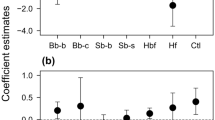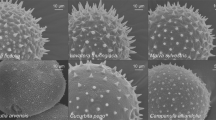Summary
Pollen carryover was measured in three species of bumble bee pollinated plants by counting the numbers of foreign grains applied to the stigmas of a series of flowers by bumble bees. Deposition declined with the number of flowers visited in a roughly exponential fashion; most grains were deposited on the first few flowers, but some grains went much farther, the maximum carryover being 54 flowers. Variation in deposition was very high. In Diervilla lonicera, bees desposited significantly more grains on flowers which contained large amounts of nectar than on drained flowers. The implications are discussed in terms of plant strategies for optimizing pollination.
Similar content being viewed by others
References
Bateman, A.J.: Cryptic self-incompatibility in the wallflower: Cheiranthus cheiri L. Heredity 10, 257–61 (1956)
Beattie, A.J.: A technique for the study of insect-borne pollen. Pan Pacif. Ent. 47, 82 (1971)
Dressler, R.L.: Pollination by euglossine bees. Evolution 22, 202–210 (1968)
Faegri, K., van der Pijl, L.: The principles of pollination ecology. Oxford: Pergamon Press (1979)
Frankie, G.W., Opler, P.A., Bawa K.S.: Foraging behaviour of solitary bees: implications for outcrossing of a neotropical tree species. J. Ecol. 64, 1049–1057 (1976)
Furgala, B., Tucker, K.W.: Holdaway, F.G.: Pollens in the proboscis fossae of honeybees foraging certain legumes. Bee Wld. 41, 210–213 (1960)
Hainsworth, F.R.: On the tongue of a hummingbird: its role in the rate and energetics of feeding. Comp. Biochem. Physiol. 46A, 65–78 (1973)
Harding, J., Barnes, K.: Genetics of Lupinus. X. Genetic variability, heterozygosity and outcrossing in colonial populations of Lupinus succulentus. Evolution 31, 247–255 (1977)
Hartling, L.K.: An investigation of the relationship between bumble bee foraging behaviour and the pollination of red clover: a component analysis approach. M.Sc. thesis, University of Toronto. pp. 92 (1979)
Hartling, L., Plowright, R.C.: An investigation of inter- and intrainflorescence visitation rates by bumble bees on red clover with special reference to seed set. Proc. IVth Int. Symp. on Pollination, Md. Agric. Exp. Sta. Spec. Misc. Publ. 1, 457–460 (1978)
Hawkins, R.P.: Length of tongue in a honey bee in relation to the pollination of red clover. J. Agric. Sci. Cambr. 73, 489–493 (1969)
heinrich, B.: Bumblebee economics. Harvard, Cambridge, Mass. (1979)
Heinrich, B., Raven, P.H.: Energetics and pollination ecology. Science 176, 597–602 (1972)
Howell, D.J.: Flock foraging in nectar-eating bats: advantages to the bats and to the host plants. Am. Nat. 114, 23–49 (1979)
Inouye, D.: Resource partitioning and community structure: a study of bumblebees in the Colorado Rocky Mountains. Ph. D. dissertation. University of North Carolina, Chapel Hill (1976)
Janzen, D.H.: A note on optimal mate selection by plants. Am. Nat. 111, 365–371 (1977)
Kevan, P.G.: Fluorescent nectar. Science 194, 341–342 (1975)
Kiang, Y.T.: Pollination study in a natural population of Mimulus guttatus De. Evolution 26, 308–310 (1972)
Kwak, M.: Pollination ecology of five hemiparasitic, large-flowered Rhinanthoideae with special reference to the pollination behavior of nectar-thieving, short-tongued bumblebees. Acta Bot. Neerl. 26, 97–107 (1977)
Laverty, T.M.: Flower-visiting behaviour of experienced and inexperienced bumblebees (Hymenoptera: Apidae). M.Sc. dissertation. University of Alberta (1978)
Levin, D.A.: Assortative pollination in Lythrum. Amer. J. Bot. 57, 1–5 (1970)
Levin, D.A., Anderson, W.W.: Competition for pollinators between simultaneously flowering species. Am. Nat. 104, 455–467 (1970)
Levin, D.A., Berube, D.E.: Phlox and Colias: the efficiency of a pollination system. Evolution 26, 242–250 (1972)
Levin, D.A., Kerster, H.W.: Natural selection for reproductive isolation in Phlox. Evolution 21, 679–687 (1967)
Levin, D.A., Kerster, H.W.: Local gene dispersal in Phlox. Evolution 22, 130–139 (1968)
Levin, D.A., Kerster, H.W.: Density-dependent gene dispersal in Liatris. Am. Nat. 103, 61–74 (1969)
Macior, L.W.: The pollination ecology of Pedicularis in Colorado. Am. J. Bot. 57, 716–728 (1970)
Macior, L.W.: Behavioral aspects of coadaptations between flower and insect polliaators. Ann. Missouri Bot. Gard. 61, 760–769 (1974)
Macior, L.W.: The pollination ecology of Pedicularis in the Yukon territory. Am. J. Bot. 62, 1065–1072 (1975)
Motten, A.F., Miller, H.L., Alexander, D.E., Campbell, D.R.: Pollination effectiveness of two insect species visiting the spring wild flower, Claytonia virginiana. Abstract in Bull Ecol. Soc. Amer. 60, 116 (1979)
Morse, D.H.: Foraging rate, foraging position, and worker size in bumble bee workers. In Proc. IVth Int. Symp. on Pollination, Md. Agric. Exp. Sta. Spec. Misc. Publ. 1, 447–452 (1978)
Primack, R.B., Silander, J.A.: Measuring the relative importance of different pollinators to plants. Nature 225, 143–144 (1975)
Pyke, G.H.: Optimal foraging in bumblebees and coevolution with their plants. Oecologia (Berl.) 36, 281–294 (1978)
Reinhardt, J.F.: Some responses of honey bees to alfalfa flowers. Am. Nat. 86, 257–275 (1952)
Robinson, W.S.: Influence of ‘Delicious’ apple blossom morphology on the behavior of nectar-gathering honey bees. In Proc. IVth Int. Symp. on Pollination, Md. Agric. Exp. Sta. Spec. Misc. Publ. 1, 393–399 (1978)
Spencer-Booth, Y.: The collection of pollen by bumble bees, and its transportation in the corbiculae and the proboscididial fossa. J. Apic. Res. 4, 185–190 (1965)
Straw, R.M.: A Markov model for pollinator constancy and competition. Am. Nat. 106, 597–620 (1972)
Thomson, J.D.: Competition and cooperation in plant-pollinator systems. Ph.D. dissertation. University of Wisconsin-Madison (1978)
Thomson, J.D.: Visitation rate patterns in animal-pollinated plants. Submitted to Ecology (1980)
Thomson, J.D., Barrett, S.C.H., Plowright, R.C.: Reproductive biology of Aralia hispida (Araliaceae) II. Behaviour of bumble bee pollinators. In prep. (1980)
Thorp, R.W., Briggs, D.L., Estes, J.R., Erickson, E.H.: Nectar fluorescence under ultraviolet irradiation. Science 189, 476–478 (1975)
van der Pijl, L., Dodson, C.H.: Orchid flowers, their pollination and evolution. University of Miami Press, Coral Gables, Fla. (1966)
Waser, N.M.: Interspecific pollen transfer and competition between co-occurring plant species. Oecologia (Berl.) 36, 223–236 (1978a)
Waser, N.M.: Competition for hummingbird pollination and sequential flowering in two Colorado wildflowers. Ecology 59, 934–944 (1978b)
Witham, T.G.: Coevolution of foraging in Bombus and nectar dispensing in Chilopsis: a last dreg theory. Science 197, 593–595 (1977)
Author information
Authors and Affiliations
Rights and permissions
About this article
Cite this article
Thomson, J.D., Plowright, R.C. Pollen carryover, nectar rewards, and pollinator behavior with special reference to Diervilla lonicera . Oecologia 46, 68–74 (1980). https://doi.org/10.1007/BF00346968
Received:
Issue Date:
DOI: https://doi.org/10.1007/BF00346968




